Business ethics in global prospect
VerifiedAdded on 2023/06/12
|11
|2566
|191
AI Summary
This article discusses the advantages of cross-cultural communication for business and measures to overcome barriers. It also covers low context and high context cultures, stereotyping, promoting cultural adaptation, communication styles of India and Australia, embodiment of group characteristics, and negative effects of cultural differences.
Contribute Materials
Your contribution can guide someone’s learning journey. Share your
documents today.

Running head: BUSINESS ETHICS IN GLOBAL PROSPECT
Business ethics in global prospect
Name of the student:
Name of the university:
Author note:
Business ethics in global prospect
Name of the student:
Name of the university:
Author note:
Secure Best Marks with AI Grader
Need help grading? Try our AI Grader for instant feedback on your assignments.
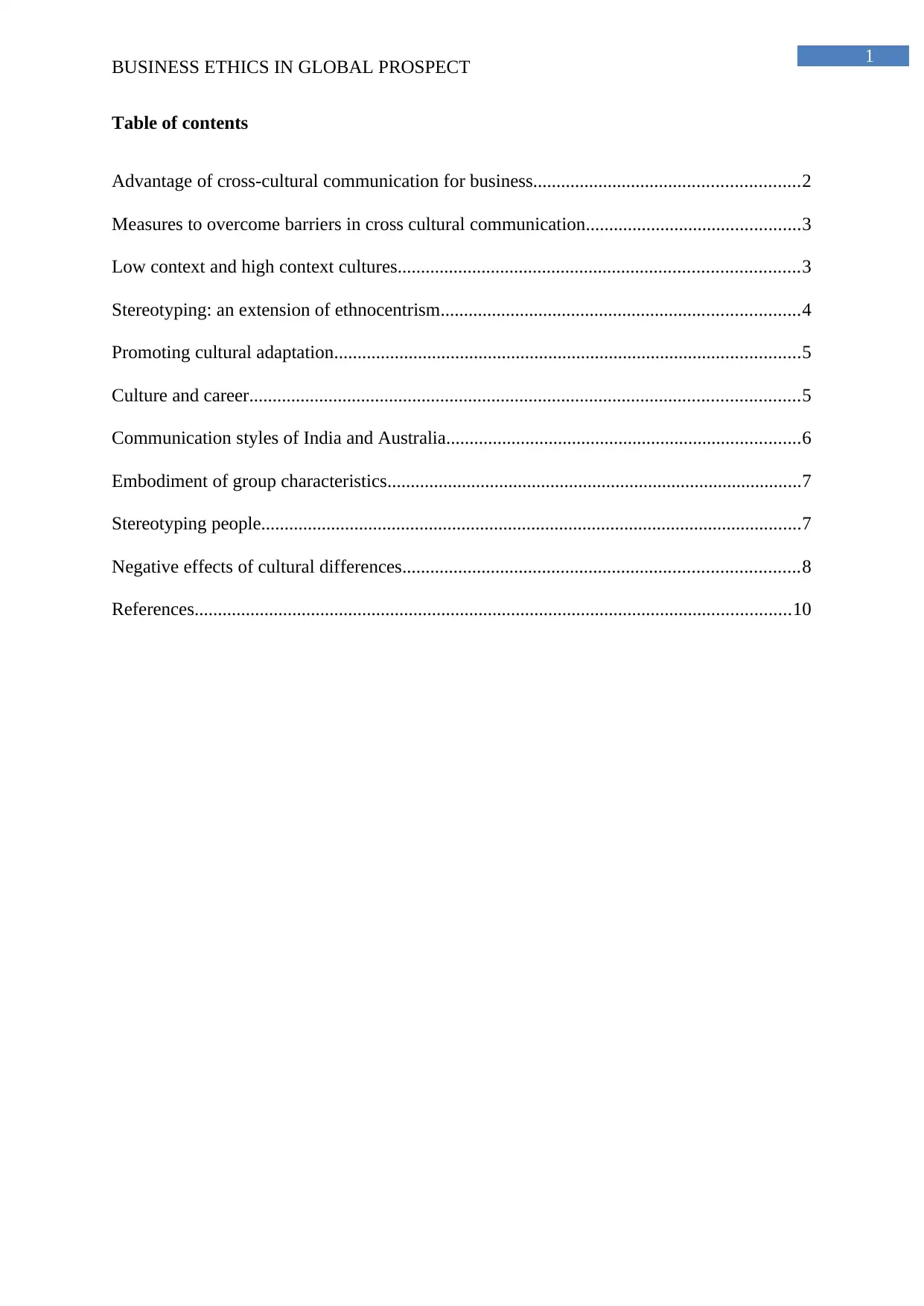
1
BUSINESS ETHICS IN GLOBAL PROSPECT
Table of contents
Advantage of cross-cultural communication for business.........................................................2
Measures to overcome barriers in cross cultural communication..............................................3
Low context and high context cultures......................................................................................3
Stereotyping: an extension of ethnocentrism.............................................................................4
Promoting cultural adaptation....................................................................................................5
Culture and career......................................................................................................................5
Communication styles of India and Australia............................................................................6
Embodiment of group characteristics.........................................................................................7
Stereotyping people....................................................................................................................7
Negative effects of cultural differences.....................................................................................8
References................................................................................................................................10
BUSINESS ETHICS IN GLOBAL PROSPECT
Table of contents
Advantage of cross-cultural communication for business.........................................................2
Measures to overcome barriers in cross cultural communication..............................................3
Low context and high context cultures......................................................................................3
Stereotyping: an extension of ethnocentrism.............................................................................4
Promoting cultural adaptation....................................................................................................5
Culture and career......................................................................................................................5
Communication styles of India and Australia............................................................................6
Embodiment of group characteristics.........................................................................................7
Stereotyping people....................................................................................................................7
Negative effects of cultural differences.....................................................................................8
References................................................................................................................................10
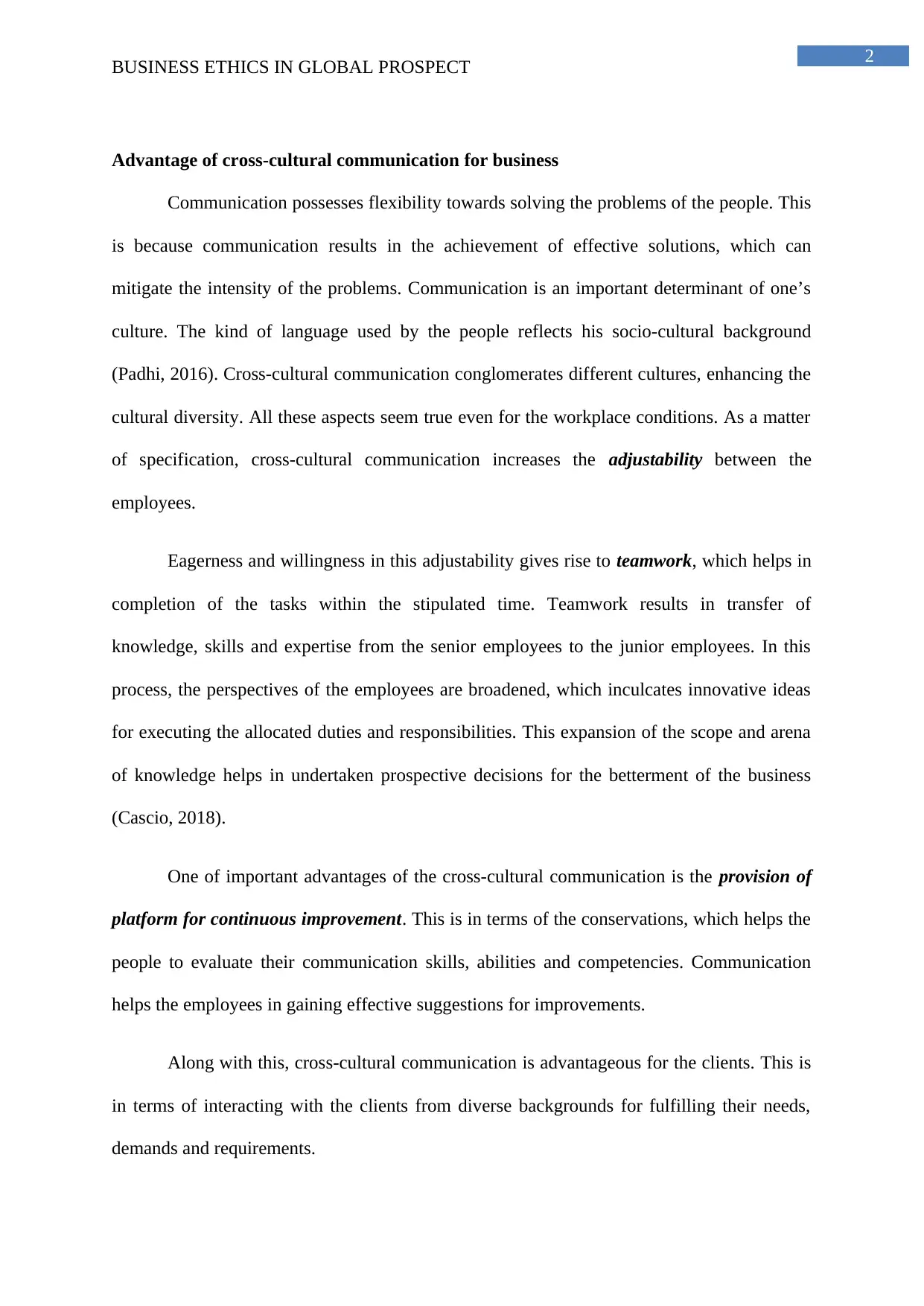
2
BUSINESS ETHICS IN GLOBAL PROSPECT
Advantage of cross-cultural communication for business
Communication possesses flexibility towards solving the problems of the people. This
is because communication results in the achievement of effective solutions, which can
mitigate the intensity of the problems. Communication is an important determinant of one’s
culture. The kind of language used by the people reflects his socio-cultural background
(Padhi, 2016). Cross-cultural communication conglomerates different cultures, enhancing the
cultural diversity. All these aspects seem true even for the workplace conditions. As a matter
of specification, cross-cultural communication increases the adjustability between the
employees.
Eagerness and willingness in this adjustability gives rise to teamwork, which helps in
completion of the tasks within the stipulated time. Teamwork results in transfer of
knowledge, skills and expertise from the senior employees to the junior employees. In this
process, the perspectives of the employees are broadened, which inculcates innovative ideas
for executing the allocated duties and responsibilities. This expansion of the scope and arena
of knowledge helps in undertaken prospective decisions for the betterment of the business
(Cascio, 2018).
One of important advantages of the cross-cultural communication is the provision of
platform for continuous improvement. This is in terms of the conservations, which helps the
people to evaluate their communication skills, abilities and competencies. Communication
helps the employees in gaining effective suggestions for improvements.
Along with this, cross-cultural communication is advantageous for the clients. This is
in terms of interacting with the clients from diverse backgrounds for fulfilling their needs,
demands and requirements.
BUSINESS ETHICS IN GLOBAL PROSPECT
Advantage of cross-cultural communication for business
Communication possesses flexibility towards solving the problems of the people. This
is because communication results in the achievement of effective solutions, which can
mitigate the intensity of the problems. Communication is an important determinant of one’s
culture. The kind of language used by the people reflects his socio-cultural background
(Padhi, 2016). Cross-cultural communication conglomerates different cultures, enhancing the
cultural diversity. All these aspects seem true even for the workplace conditions. As a matter
of specification, cross-cultural communication increases the adjustability between the
employees.
Eagerness and willingness in this adjustability gives rise to teamwork, which helps in
completion of the tasks within the stipulated time. Teamwork results in transfer of
knowledge, skills and expertise from the senior employees to the junior employees. In this
process, the perspectives of the employees are broadened, which inculcates innovative ideas
for executing the allocated duties and responsibilities. This expansion of the scope and arena
of knowledge helps in undertaken prospective decisions for the betterment of the business
(Cascio, 2018).
One of important advantages of the cross-cultural communication is the provision of
platform for continuous improvement. This is in terms of the conservations, which helps the
people to evaluate their communication skills, abilities and competencies. Communication
helps the employees in gaining effective suggestions for improvements.
Along with this, cross-cultural communication is advantageous for the clients. This is
in terms of interacting with the clients from diverse backgrounds for fulfilling their needs,
demands and requirements.
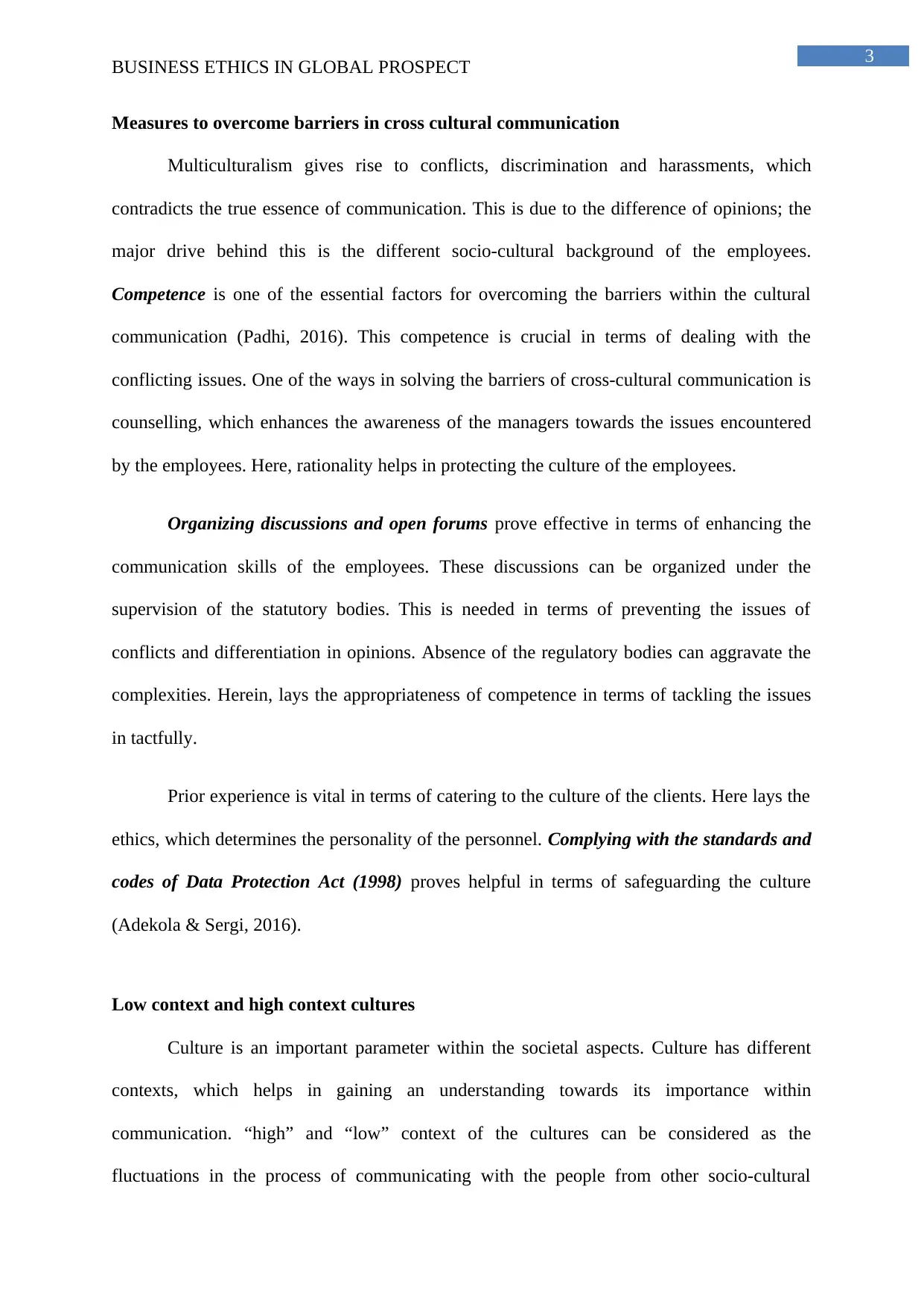
3
BUSINESS ETHICS IN GLOBAL PROSPECT
Measures to overcome barriers in cross cultural communication
Multiculturalism gives rise to conflicts, discrimination and harassments, which
contradicts the true essence of communication. This is due to the difference of opinions; the
major drive behind this is the different socio-cultural background of the employees.
Competence is one of the essential factors for overcoming the barriers within the cultural
communication (Padhi, 2016). This competence is crucial in terms of dealing with the
conflicting issues. One of the ways in solving the barriers of cross-cultural communication is
counselling, which enhances the awareness of the managers towards the issues encountered
by the employees. Here, rationality helps in protecting the culture of the employees.
Organizing discussions and open forums prove effective in terms of enhancing the
communication skills of the employees. These discussions can be organized under the
supervision of the statutory bodies. This is needed in terms of preventing the issues of
conflicts and differentiation in opinions. Absence of the regulatory bodies can aggravate the
complexities. Herein, lays the appropriateness of competence in terms of tackling the issues
in tactfully.
Prior experience is vital in terms of catering to the culture of the clients. Here lays the
ethics, which determines the personality of the personnel. Complying with the standards and
codes of Data Protection Act (1998) proves helpful in terms of safeguarding the culture
(Adekola & Sergi, 2016).
Low context and high context cultures
Culture is an important parameter within the societal aspects. Culture has different
contexts, which helps in gaining an understanding towards its importance within
communication. “high” and “low” context of the cultures can be considered as the
fluctuations in the process of communicating with the people from other socio-cultural
BUSINESS ETHICS IN GLOBAL PROSPECT
Measures to overcome barriers in cross cultural communication
Multiculturalism gives rise to conflicts, discrimination and harassments, which
contradicts the true essence of communication. This is due to the difference of opinions; the
major drive behind this is the different socio-cultural background of the employees.
Competence is one of the essential factors for overcoming the barriers within the cultural
communication (Padhi, 2016). This competence is crucial in terms of dealing with the
conflicting issues. One of the ways in solving the barriers of cross-cultural communication is
counselling, which enhances the awareness of the managers towards the issues encountered
by the employees. Here, rationality helps in protecting the culture of the employees.
Organizing discussions and open forums prove effective in terms of enhancing the
communication skills of the employees. These discussions can be organized under the
supervision of the statutory bodies. This is needed in terms of preventing the issues of
conflicts and differentiation in opinions. Absence of the regulatory bodies can aggravate the
complexities. Herein, lays the appropriateness of competence in terms of tackling the issues
in tactfully.
Prior experience is vital in terms of catering to the culture of the clients. Here lays the
ethics, which determines the personality of the personnel. Complying with the standards and
codes of Data Protection Act (1998) proves helpful in terms of safeguarding the culture
(Adekola & Sergi, 2016).
Low context and high context cultures
Culture is an important parameter within the societal aspects. Culture has different
contexts, which helps in gaining an understanding towards its importance within
communication. “high” and “low” context of the cultures can be considered as the
fluctuations in the process of communicating with the people from other socio-cultural
Secure Best Marks with AI Grader
Need help grading? Try our AI Grader for instant feedback on your assignments.
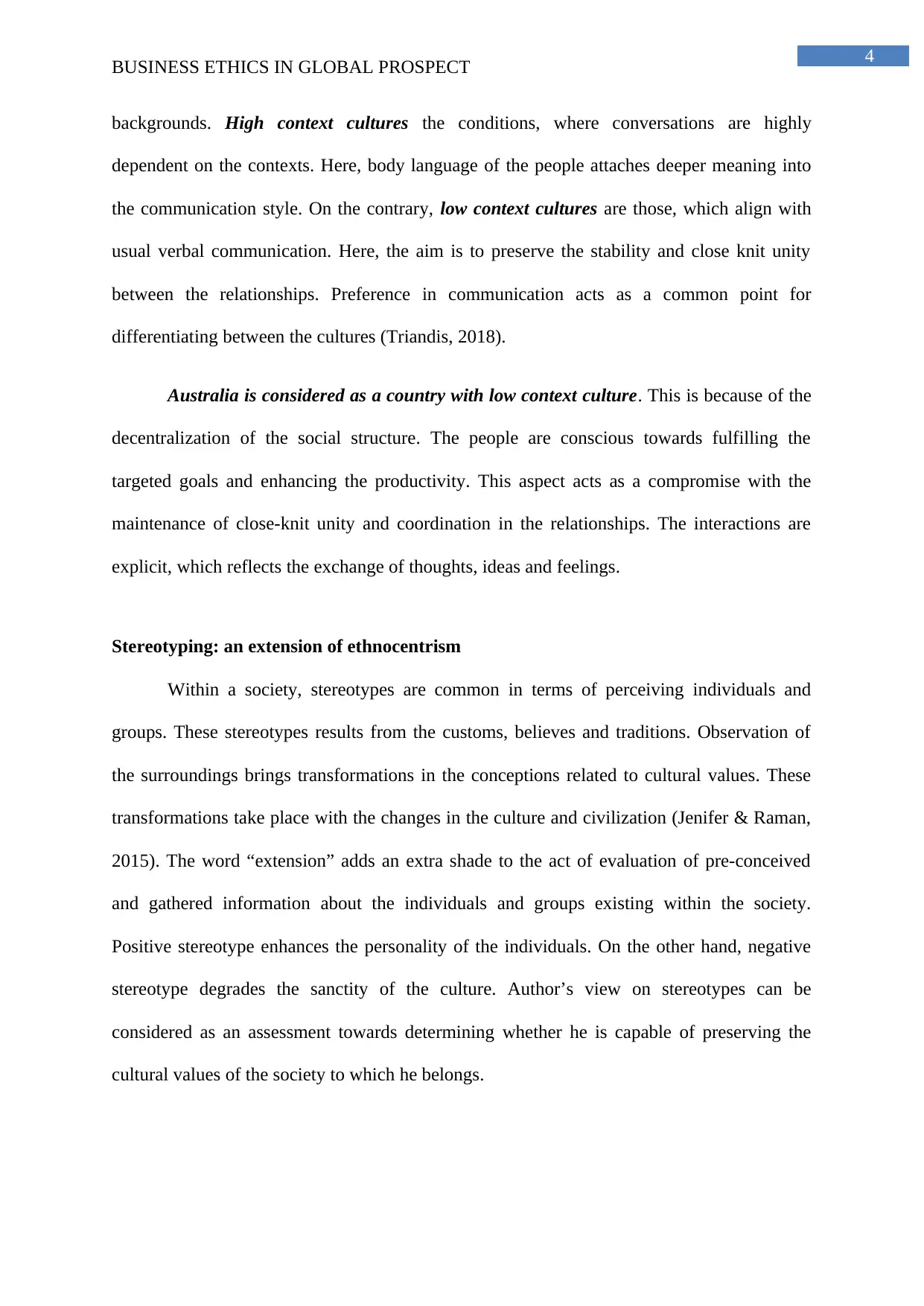
4
BUSINESS ETHICS IN GLOBAL PROSPECT
backgrounds. High context cultures the conditions, where conversations are highly
dependent on the contexts. Here, body language of the people attaches deeper meaning into
the communication style. On the contrary, low context cultures are those, which align with
usual verbal communication. Here, the aim is to preserve the stability and close knit unity
between the relationships. Preference in communication acts as a common point for
differentiating between the cultures (Triandis, 2018).
Australia is considered as a country with low context culture. This is because of the
decentralization of the social structure. The people are conscious towards fulfilling the
targeted goals and enhancing the productivity. This aspect acts as a compromise with the
maintenance of close-knit unity and coordination in the relationships. The interactions are
explicit, which reflects the exchange of thoughts, ideas and feelings.
Stereotyping: an extension of ethnocentrism
Within a society, stereotypes are common in terms of perceiving individuals and
groups. These stereotypes results from the customs, believes and traditions. Observation of
the surroundings brings transformations in the conceptions related to cultural values. These
transformations take place with the changes in the culture and civilization (Jenifer & Raman,
2015). The word “extension” adds an extra shade to the act of evaluation of pre-conceived
and gathered information about the individuals and groups existing within the society.
Positive stereotype enhances the personality of the individuals. On the other hand, negative
stereotype degrades the sanctity of the culture. Author’s view on stereotypes can be
considered as an assessment towards determining whether he is capable of preserving the
cultural values of the society to which he belongs.
BUSINESS ETHICS IN GLOBAL PROSPECT
backgrounds. High context cultures the conditions, where conversations are highly
dependent on the contexts. Here, body language of the people attaches deeper meaning into
the communication style. On the contrary, low context cultures are those, which align with
usual verbal communication. Here, the aim is to preserve the stability and close knit unity
between the relationships. Preference in communication acts as a common point for
differentiating between the cultures (Triandis, 2018).
Australia is considered as a country with low context culture. This is because of the
decentralization of the social structure. The people are conscious towards fulfilling the
targeted goals and enhancing the productivity. This aspect acts as a compromise with the
maintenance of close-knit unity and coordination in the relationships. The interactions are
explicit, which reflects the exchange of thoughts, ideas and feelings.
Stereotyping: an extension of ethnocentrism
Within a society, stereotypes are common in terms of perceiving individuals and
groups. These stereotypes results from the customs, believes and traditions. Observation of
the surroundings brings transformations in the conceptions related to cultural values. These
transformations take place with the changes in the culture and civilization (Jenifer & Raman,
2015). The word “extension” adds an extra shade to the act of evaluation of pre-conceived
and gathered information about the individuals and groups existing within the society.
Positive stereotype enhances the personality of the individuals. On the other hand, negative
stereotype degrades the sanctity of the culture. Author’s view on stereotypes can be
considered as an assessment towards determining whether he is capable of preserving the
cultural values of the society to which he belongs.
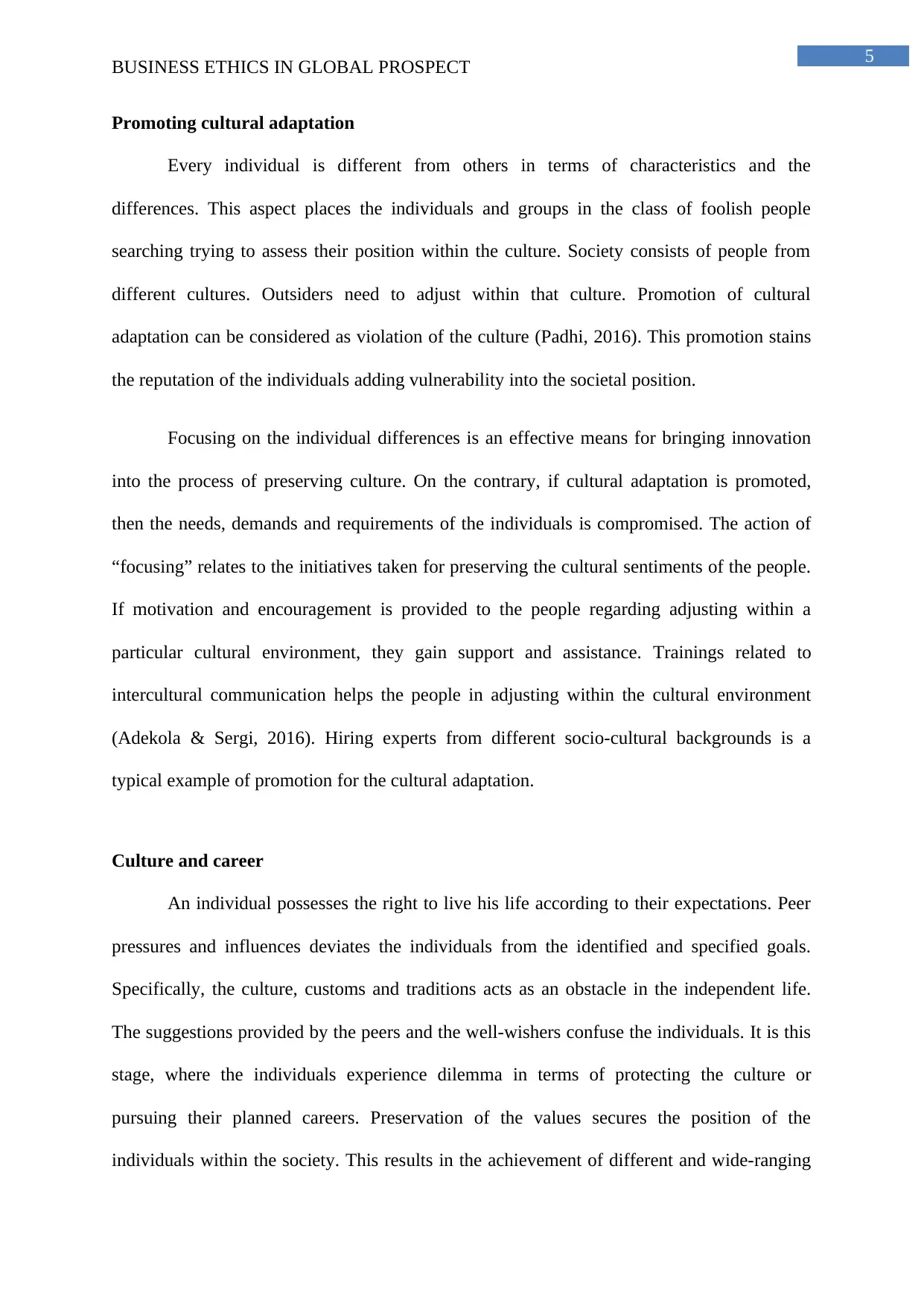
5
BUSINESS ETHICS IN GLOBAL PROSPECT
Promoting cultural adaptation
Every individual is different from others in terms of characteristics and the
differences. This aspect places the individuals and groups in the class of foolish people
searching trying to assess their position within the culture. Society consists of people from
different cultures. Outsiders need to adjust within that culture. Promotion of cultural
adaptation can be considered as violation of the culture (Padhi, 2016). This promotion stains
the reputation of the individuals adding vulnerability into the societal position.
Focusing on the individual differences is an effective means for bringing innovation
into the process of preserving culture. On the contrary, if cultural adaptation is promoted,
then the needs, demands and requirements of the individuals is compromised. The action of
“focusing” relates to the initiatives taken for preserving the cultural sentiments of the people.
If motivation and encouragement is provided to the people regarding adjusting within a
particular cultural environment, they gain support and assistance. Trainings related to
intercultural communication helps the people in adjusting within the cultural environment
(Adekola & Sergi, 2016). Hiring experts from different socio-cultural backgrounds is a
typical example of promotion for the cultural adaptation.
Culture and career
An individual possesses the right to live his life according to their expectations. Peer
pressures and influences deviates the individuals from the identified and specified goals.
Specifically, the culture, customs and traditions acts as an obstacle in the independent life.
The suggestions provided by the peers and the well-wishers confuse the individuals. It is this
stage, where the individuals experience dilemma in terms of protecting the culture or
pursuing their planned careers. Preservation of the values secures the position of the
individuals within the society. This results in the achievement of different and wide-ranging
BUSINESS ETHICS IN GLOBAL PROSPECT
Promoting cultural adaptation
Every individual is different from others in terms of characteristics and the
differences. This aspect places the individuals and groups in the class of foolish people
searching trying to assess their position within the culture. Society consists of people from
different cultures. Outsiders need to adjust within that culture. Promotion of cultural
adaptation can be considered as violation of the culture (Padhi, 2016). This promotion stains
the reputation of the individuals adding vulnerability into the societal position.
Focusing on the individual differences is an effective means for bringing innovation
into the process of preserving culture. On the contrary, if cultural adaptation is promoted,
then the needs, demands and requirements of the individuals is compromised. The action of
“focusing” relates to the initiatives taken for preserving the cultural sentiments of the people.
If motivation and encouragement is provided to the people regarding adjusting within a
particular cultural environment, they gain support and assistance. Trainings related to
intercultural communication helps the people in adjusting within the cultural environment
(Adekola & Sergi, 2016). Hiring experts from different socio-cultural backgrounds is a
typical example of promotion for the cultural adaptation.
Culture and career
An individual possesses the right to live his life according to their expectations. Peer
pressures and influences deviates the individuals from the identified and specified goals.
Specifically, the culture, customs and traditions acts as an obstacle in the independent life.
The suggestions provided by the peers and the well-wishers confuse the individuals. It is this
stage, where the individuals experience dilemma in terms of protecting the culture or
pursuing their planned careers. Preservation of the values secures the position of the
individuals within the society. This results in the achievement of different and wide-ranging
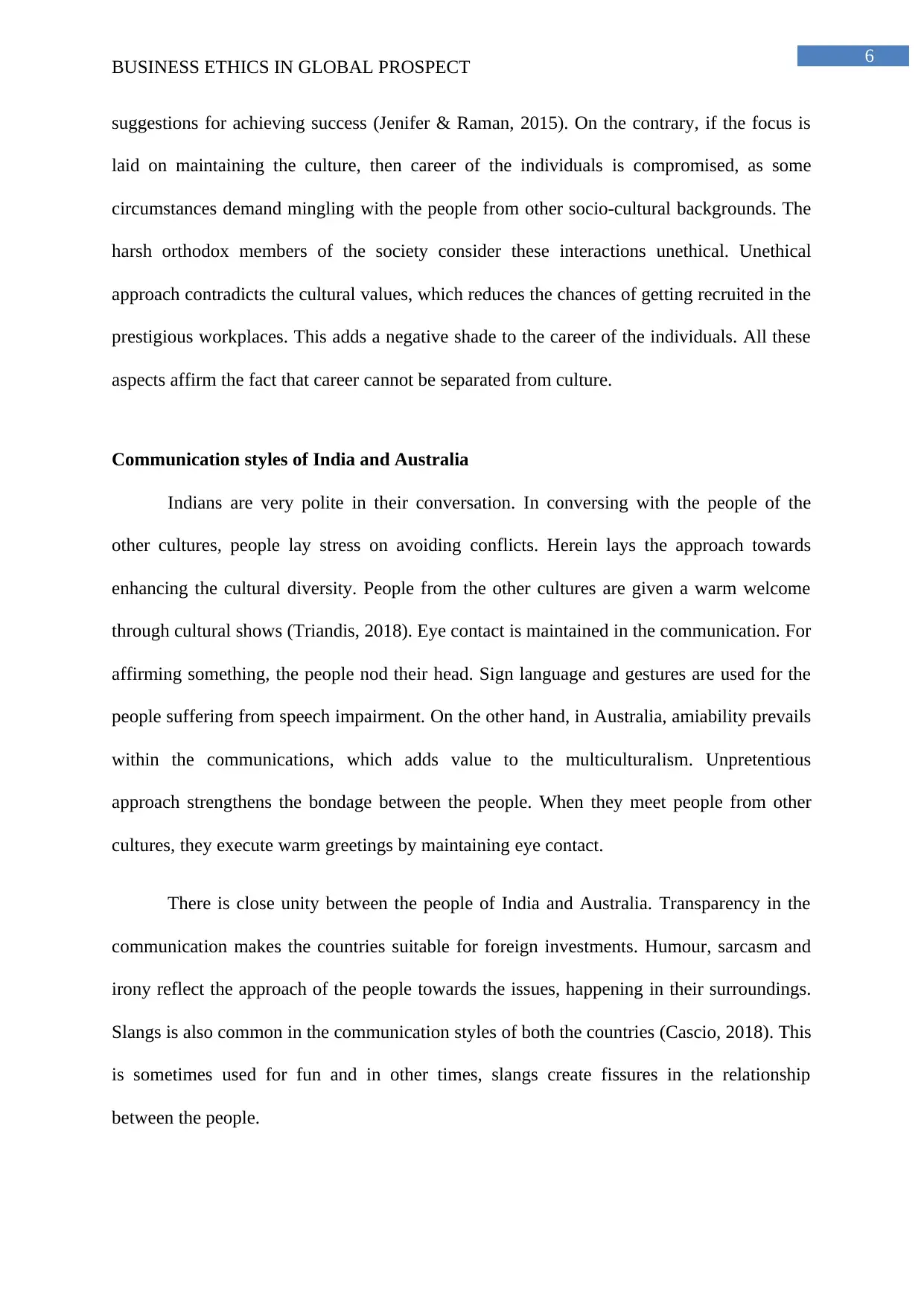
6
BUSINESS ETHICS IN GLOBAL PROSPECT
suggestions for achieving success (Jenifer & Raman, 2015). On the contrary, if the focus is
laid on maintaining the culture, then career of the individuals is compromised, as some
circumstances demand mingling with the people from other socio-cultural backgrounds. The
harsh orthodox members of the society consider these interactions unethical. Unethical
approach contradicts the cultural values, which reduces the chances of getting recruited in the
prestigious workplaces. This adds a negative shade to the career of the individuals. All these
aspects affirm the fact that career cannot be separated from culture.
Communication styles of India and Australia
Indians are very polite in their conversation. In conversing with the people of the
other cultures, people lay stress on avoiding conflicts. Herein lays the approach towards
enhancing the cultural diversity. People from the other cultures are given a warm welcome
through cultural shows (Triandis, 2018). Eye contact is maintained in the communication. For
affirming something, the people nod their head. Sign language and gestures are used for the
people suffering from speech impairment. On the other hand, in Australia, amiability prevails
within the communications, which adds value to the multiculturalism. Unpretentious
approach strengthens the bondage between the people. When they meet people from other
cultures, they execute warm greetings by maintaining eye contact.
There is close unity between the people of India and Australia. Transparency in the
communication makes the countries suitable for foreign investments. Humour, sarcasm and
irony reflect the approach of the people towards the issues, happening in their surroundings.
Slangs is also common in the communication styles of both the countries (Cascio, 2018). This
is sometimes used for fun and in other times, slangs create fissures in the relationship
between the people.
BUSINESS ETHICS IN GLOBAL PROSPECT
suggestions for achieving success (Jenifer & Raman, 2015). On the contrary, if the focus is
laid on maintaining the culture, then career of the individuals is compromised, as some
circumstances demand mingling with the people from other socio-cultural backgrounds. The
harsh orthodox members of the society consider these interactions unethical. Unethical
approach contradicts the cultural values, which reduces the chances of getting recruited in the
prestigious workplaces. This adds a negative shade to the career of the individuals. All these
aspects affirm the fact that career cannot be separated from culture.
Communication styles of India and Australia
Indians are very polite in their conversation. In conversing with the people of the
other cultures, people lay stress on avoiding conflicts. Herein lays the approach towards
enhancing the cultural diversity. People from the other cultures are given a warm welcome
through cultural shows (Triandis, 2018). Eye contact is maintained in the communication. For
affirming something, the people nod their head. Sign language and gestures are used for the
people suffering from speech impairment. On the other hand, in Australia, amiability prevails
within the communications, which adds value to the multiculturalism. Unpretentious
approach strengthens the bondage between the people. When they meet people from other
cultures, they execute warm greetings by maintaining eye contact.
There is close unity between the people of India and Australia. Transparency in the
communication makes the countries suitable for foreign investments. Humour, sarcasm and
irony reflect the approach of the people towards the issues, happening in their surroundings.
Slangs is also common in the communication styles of both the countries (Cascio, 2018). This
is sometimes used for fun and in other times, slangs create fissures in the relationship
between the people.
Paraphrase This Document
Need a fresh take? Get an instant paraphrase of this document with our AI Paraphraser
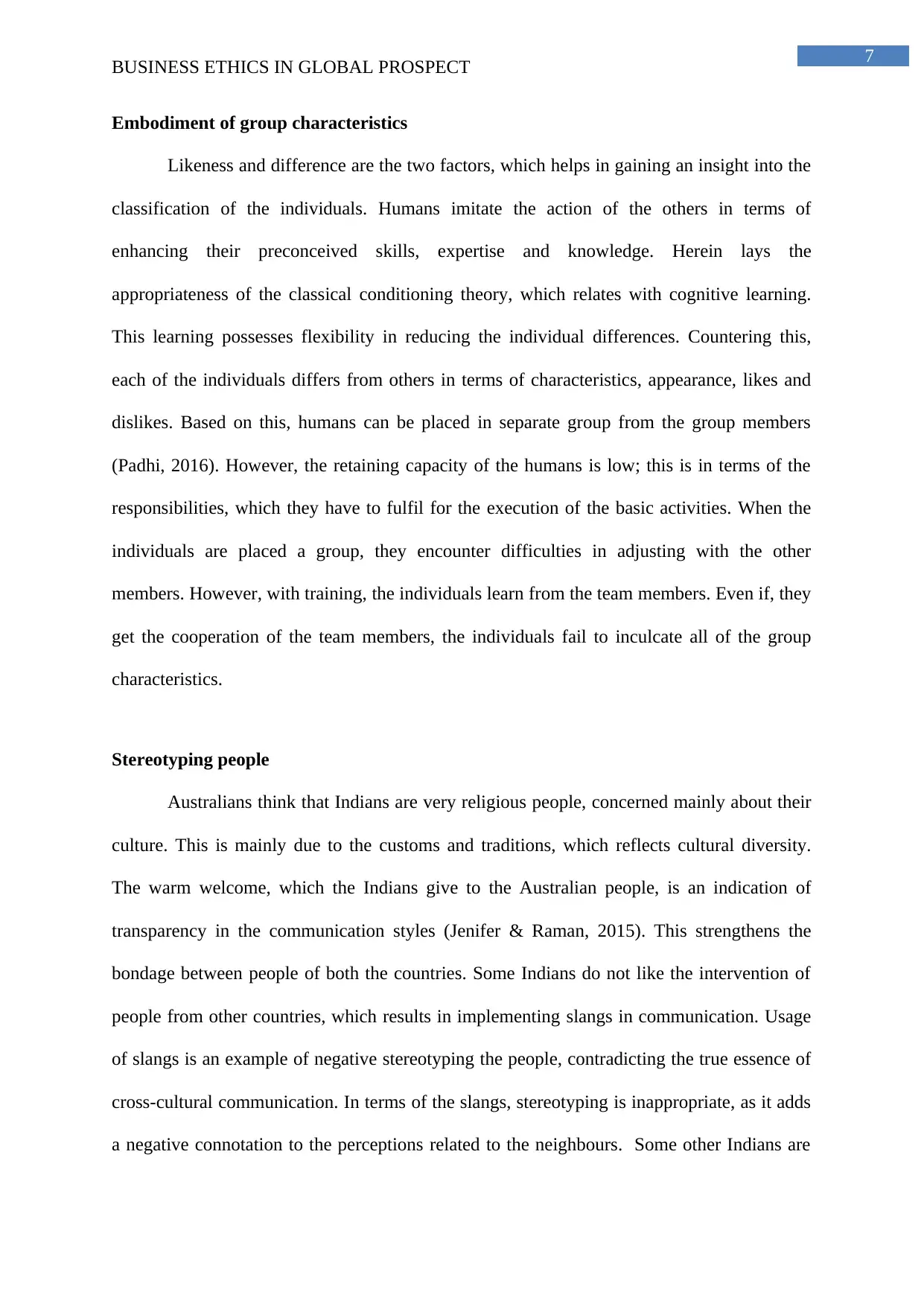
7
BUSINESS ETHICS IN GLOBAL PROSPECT
Embodiment of group characteristics
Likeness and difference are the two factors, which helps in gaining an insight into the
classification of the individuals. Humans imitate the action of the others in terms of
enhancing their preconceived skills, expertise and knowledge. Herein lays the
appropriateness of the classical conditioning theory, which relates with cognitive learning.
This learning possesses flexibility in reducing the individual differences. Countering this,
each of the individuals differs from others in terms of characteristics, appearance, likes and
dislikes. Based on this, humans can be placed in separate group from the group members
(Padhi, 2016). However, the retaining capacity of the humans is low; this is in terms of the
responsibilities, which they have to fulfil for the execution of the basic activities. When the
individuals are placed a group, they encounter difficulties in adjusting with the other
members. However, with training, the individuals learn from the team members. Even if, they
get the cooperation of the team members, the individuals fail to inculcate all of the group
characteristics.
Stereotyping people
Australians think that Indians are very religious people, concerned mainly about their
culture. This is mainly due to the customs and traditions, which reflects cultural diversity.
The warm welcome, which the Indians give to the Australian people, is an indication of
transparency in the communication styles (Jenifer & Raman, 2015). This strengthens the
bondage between people of both the countries. Some Indians do not like the intervention of
people from other countries, which results in implementing slangs in communication. Usage
of slangs is an example of negative stereotyping the people, contradicting the true essence of
cross-cultural communication. In terms of the slangs, stereotyping is inappropriate, as it adds
a negative connotation to the perceptions related to the neighbours. Some other Indians are
BUSINESS ETHICS IN GLOBAL PROSPECT
Embodiment of group characteristics
Likeness and difference are the two factors, which helps in gaining an insight into the
classification of the individuals. Humans imitate the action of the others in terms of
enhancing their preconceived skills, expertise and knowledge. Herein lays the
appropriateness of the classical conditioning theory, which relates with cognitive learning.
This learning possesses flexibility in reducing the individual differences. Countering this,
each of the individuals differs from others in terms of characteristics, appearance, likes and
dislikes. Based on this, humans can be placed in separate group from the group members
(Padhi, 2016). However, the retaining capacity of the humans is low; this is in terms of the
responsibilities, which they have to fulfil for the execution of the basic activities. When the
individuals are placed a group, they encounter difficulties in adjusting with the other
members. However, with training, the individuals learn from the team members. Even if, they
get the cooperation of the team members, the individuals fail to inculcate all of the group
characteristics.
Stereotyping people
Australians think that Indians are very religious people, concerned mainly about their
culture. This is mainly due to the customs and traditions, which reflects cultural diversity.
The warm welcome, which the Indians give to the Australian people, is an indication of
transparency in the communication styles (Jenifer & Raman, 2015). This strengthens the
bondage between people of both the countries. Some Indians do not like the intervention of
people from other countries, which results in implementing slangs in communication. Usage
of slangs is an example of negative stereotyping the people, contradicting the true essence of
cross-cultural communication. In terms of the slangs, stereotyping is inappropriate, as it adds
a negative connotation to the perceptions related to the neighbours. Some other Indians are
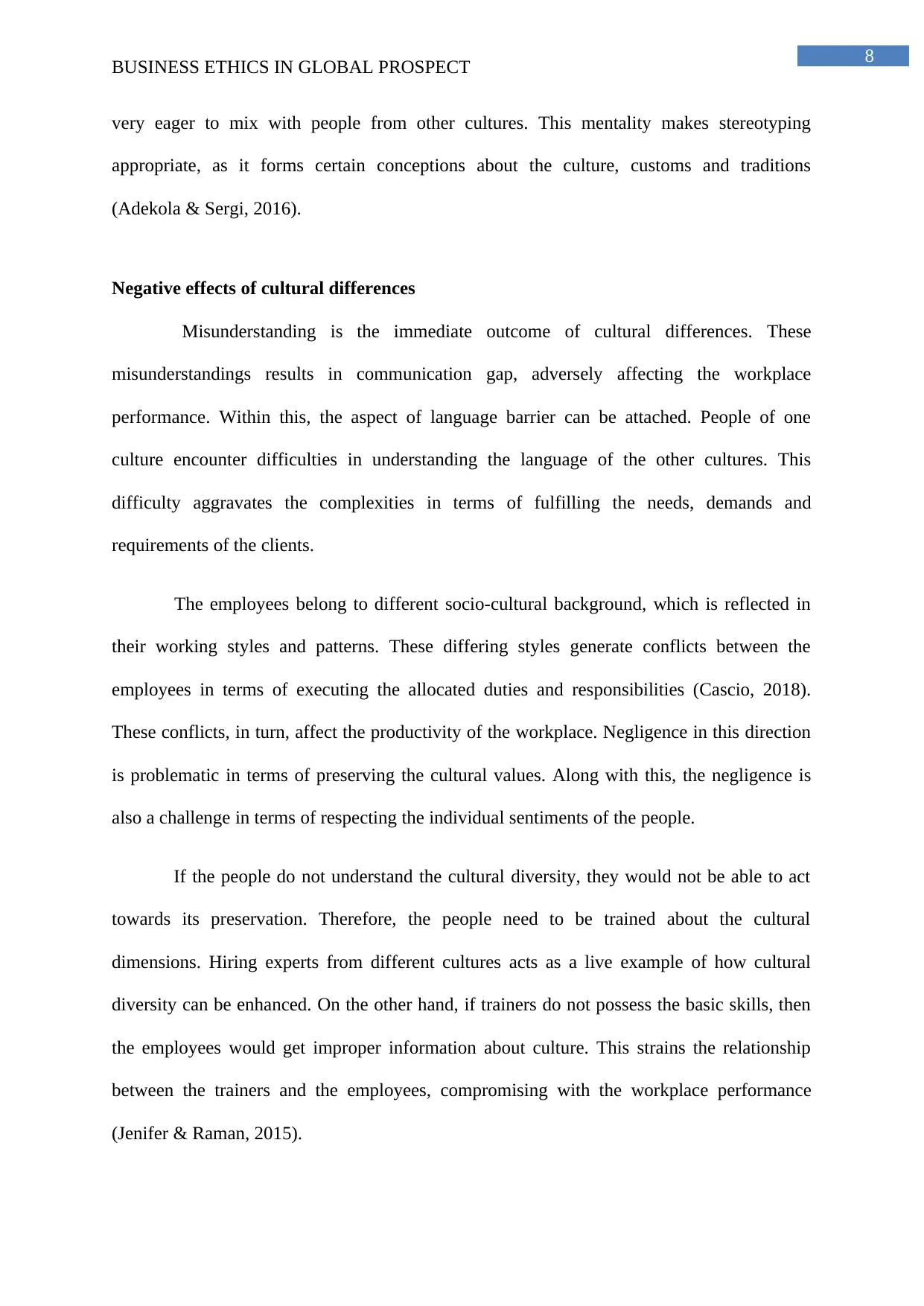
8
BUSINESS ETHICS IN GLOBAL PROSPECT
very eager to mix with people from other cultures. This mentality makes stereotyping
appropriate, as it forms certain conceptions about the culture, customs and traditions
(Adekola & Sergi, 2016).
Negative effects of cultural differences
Misunderstanding is the immediate outcome of cultural differences. These
misunderstandings results in communication gap, adversely affecting the workplace
performance. Within this, the aspect of language barrier can be attached. People of one
culture encounter difficulties in understanding the language of the other cultures. This
difficulty aggravates the complexities in terms of fulfilling the needs, demands and
requirements of the clients.
The employees belong to different socio-cultural background, which is reflected in
their working styles and patterns. These differing styles generate conflicts between the
employees in terms of executing the allocated duties and responsibilities (Cascio, 2018).
These conflicts, in turn, affect the productivity of the workplace. Negligence in this direction
is problematic in terms of preserving the cultural values. Along with this, the negligence is
also a challenge in terms of respecting the individual sentiments of the people.
If the people do not understand the cultural diversity, they would not be able to act
towards its preservation. Therefore, the people need to be trained about the cultural
dimensions. Hiring experts from different cultures acts as a live example of how cultural
diversity can be enhanced. On the other hand, if trainers do not possess the basic skills, then
the employees would get improper information about culture. This strains the relationship
between the trainers and the employees, compromising with the workplace performance
(Jenifer & Raman, 2015).
BUSINESS ETHICS IN GLOBAL PROSPECT
very eager to mix with people from other cultures. This mentality makes stereotyping
appropriate, as it forms certain conceptions about the culture, customs and traditions
(Adekola & Sergi, 2016).
Negative effects of cultural differences
Misunderstanding is the immediate outcome of cultural differences. These
misunderstandings results in communication gap, adversely affecting the workplace
performance. Within this, the aspect of language barrier can be attached. People of one
culture encounter difficulties in understanding the language of the other cultures. This
difficulty aggravates the complexities in terms of fulfilling the needs, demands and
requirements of the clients.
The employees belong to different socio-cultural background, which is reflected in
their working styles and patterns. These differing styles generate conflicts between the
employees in terms of executing the allocated duties and responsibilities (Cascio, 2018).
These conflicts, in turn, affect the productivity of the workplace. Negligence in this direction
is problematic in terms of preserving the cultural values. Along with this, the negligence is
also a challenge in terms of respecting the individual sentiments of the people.
If the people do not understand the cultural diversity, they would not be able to act
towards its preservation. Therefore, the people need to be trained about the cultural
dimensions. Hiring experts from different cultures acts as a live example of how cultural
diversity can be enhanced. On the other hand, if trainers do not possess the basic skills, then
the employees would get improper information about culture. This strains the relationship
between the trainers and the employees, compromising with the workplace performance
(Jenifer & Raman, 2015).
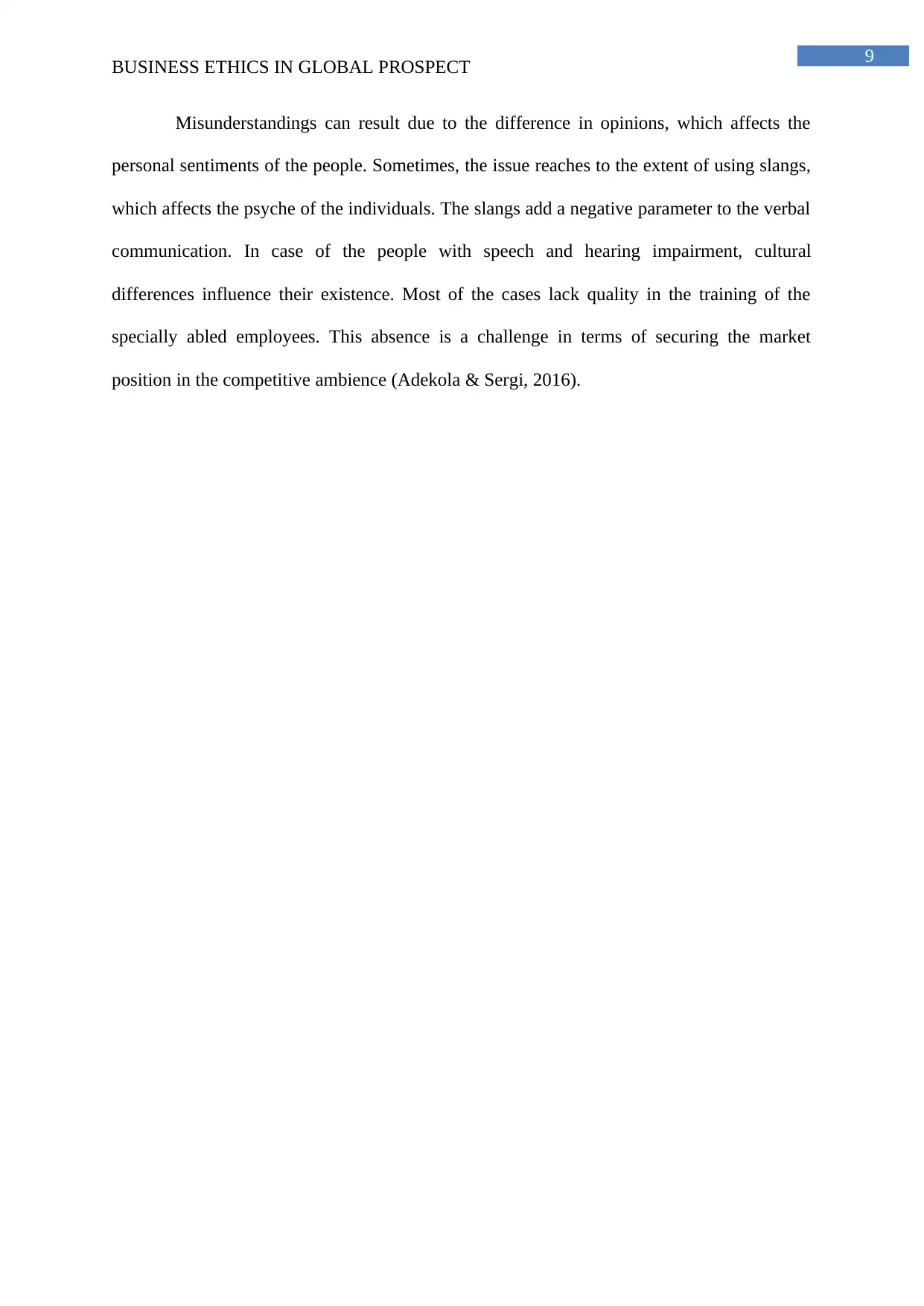
9
BUSINESS ETHICS IN GLOBAL PROSPECT
Misunderstandings can result due to the difference in opinions, which affects the
personal sentiments of the people. Sometimes, the issue reaches to the extent of using slangs,
which affects the psyche of the individuals. The slangs add a negative parameter to the verbal
communication. In case of the people with speech and hearing impairment, cultural
differences influence their existence. Most of the cases lack quality in the training of the
specially abled employees. This absence is a challenge in terms of securing the market
position in the competitive ambience (Adekola & Sergi, 2016).
BUSINESS ETHICS IN GLOBAL PROSPECT
Misunderstandings can result due to the difference in opinions, which affects the
personal sentiments of the people. Sometimes, the issue reaches to the extent of using slangs,
which affects the psyche of the individuals. The slangs add a negative parameter to the verbal
communication. In case of the people with speech and hearing impairment, cultural
differences influence their existence. Most of the cases lack quality in the training of the
specially abled employees. This absence is a challenge in terms of securing the market
position in the competitive ambience (Adekola & Sergi, 2016).
Secure Best Marks with AI Grader
Need help grading? Try our AI Grader for instant feedback on your assignments.
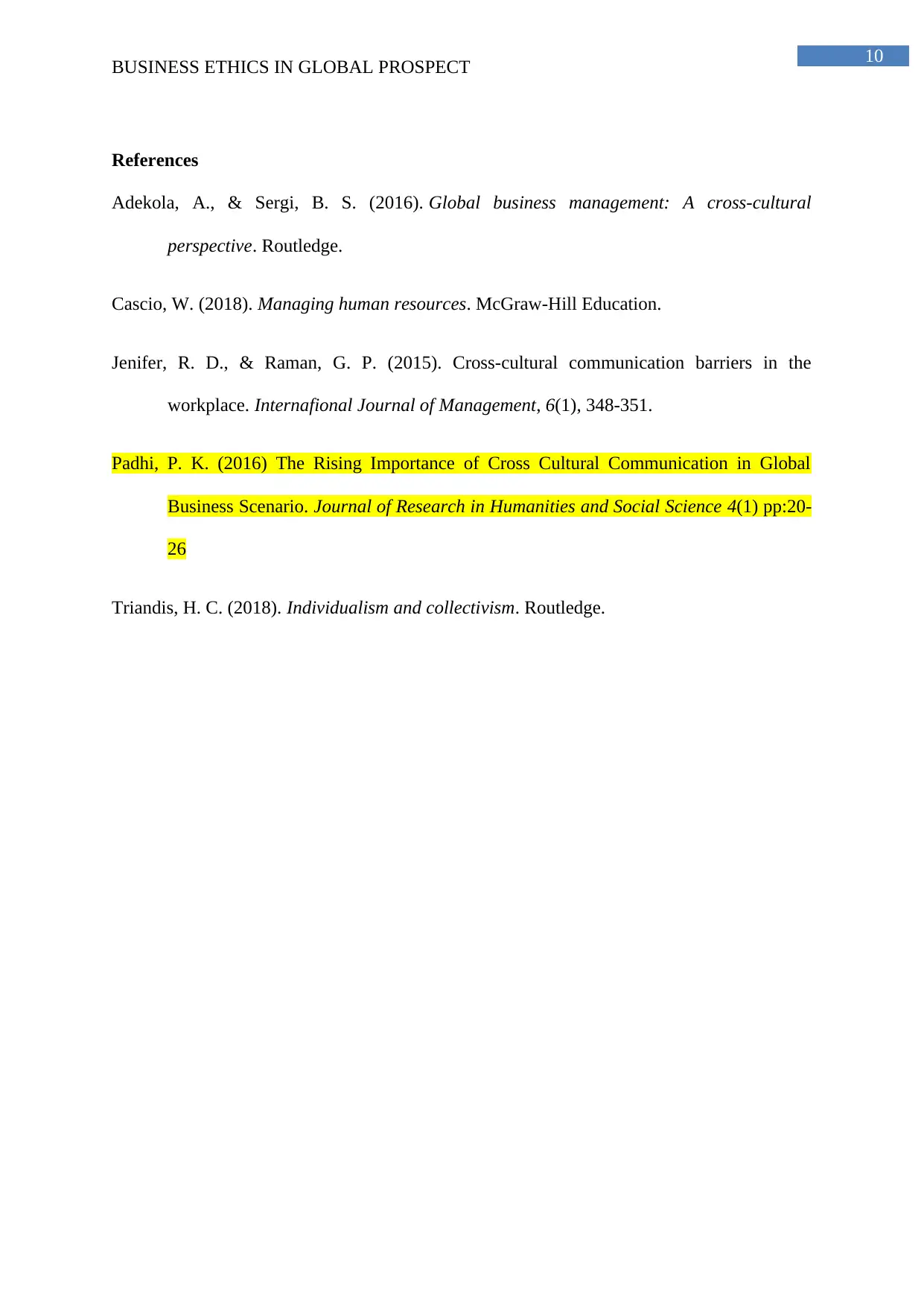
10
BUSINESS ETHICS IN GLOBAL PROSPECT
References
Adekola, A., & Sergi, B. S. (2016). Global business management: A cross-cultural
perspective. Routledge.
Cascio, W. (2018). Managing human resources. McGraw-Hill Education.
Jenifer, R. D., & Raman, G. P. (2015). Cross-cultural communication barriers in the
workplace. Internafional Journal of Management, 6(1), 348-351.
Padhi, P. K. (2016) The Rising Importance of Cross Cultural Communication in Global
Business Scenario. Journal of Research in Humanities and Social Science 4(1) pp:20-
26
Triandis, H. C. (2018). Individualism and collectivism. Routledge.
BUSINESS ETHICS IN GLOBAL PROSPECT
References
Adekola, A., & Sergi, B. S. (2016). Global business management: A cross-cultural
perspective. Routledge.
Cascio, W. (2018). Managing human resources. McGraw-Hill Education.
Jenifer, R. D., & Raman, G. P. (2015). Cross-cultural communication barriers in the
workplace. Internafional Journal of Management, 6(1), 348-351.
Padhi, P. K. (2016) The Rising Importance of Cross Cultural Communication in Global
Business Scenario. Journal of Research in Humanities and Social Science 4(1) pp:20-
26
Triandis, H. C. (2018). Individualism and collectivism. Routledge.
1 out of 11
Related Documents
Your All-in-One AI-Powered Toolkit for Academic Success.
+13062052269
info@desklib.com
Available 24*7 on WhatsApp / Email
![[object Object]](/_next/static/media/star-bottom.7253800d.svg)
Unlock your academic potential
© 2024 | Zucol Services PVT LTD | All rights reserved.





